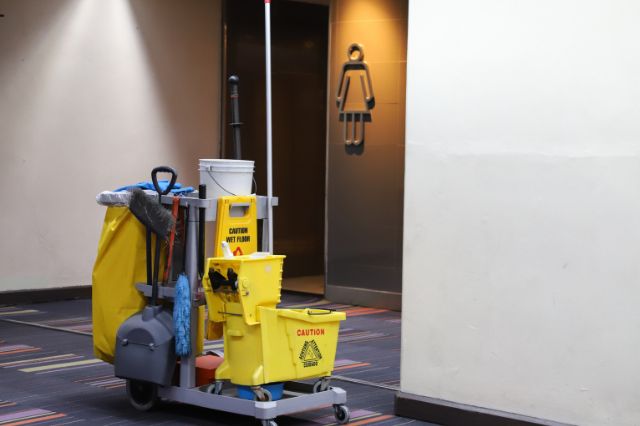Work
5 Benefits of Good Office Chairs


Around the world, over 4 million people have back pain as a result of working too long on uncomfortable chairs.
If we consider an average of 9-5 employees sitting on the same uncomfortable chair for the same number of hours, then this figure doesn’t seem too surprising.
This point is often ignored while maintaining office space but if ignored for a long time, it can create several health complications among individuals, which will again impact the business as a whole.
The only solution to this issue is switching the normal stiff chairs with comfortable ergonomic chairs. Yes, that’s right. A good office chair is a simple and effective solution to all your problems, some of which are discussed below.
1. Boosts comfort
Just like you seek comfort in your chair when entering your office, then why should your employees be any different? A good office chair boosts comfort by a huge percentage.
According to a survey conducted by Staples, on office seats and work environments, 86% of the respondents revealed their biggest cause of discomfort was the chair.
Not having a good chair will not only impact their comfort levels but will also distract them from focusing on their work. Whereas a good chair will accompany the employees to keep the already focused mind more intact and directed at work.
2. Improves productivity
Comfort and productivity go hand in hand. If employees seek a tea break every hour to take rest from their uncomfortable, stiff chairs, it will disrupt their productivity levels to a large extent, which will further impact employee morale and the business as well.
You can prevent all this if you invest in a good office chair. A comfortable chair will help employees sit on their chairs for hours without the need for any breaks. Hence, productivity is bound to increase.
Also, after breaks, they won’t feel like, “oh no, not again!” because they would actually look forward to continuing their work instead of ranting in the lunch breaks.
3. Minimizes neck problems
Ergonomic chairs are the ones that are specifically designed to adjust to employees’ needs, maintain their posture, and avoid any kinds of body pains. After sitting for long hours, the pressure on the hips increases, the body becomes stiff, and hence the neck and back start to ache.
This shouldn’t be taken lightly because your employees are the wheels of your organization. Investing in good chairs like the ones available at https://www.homemakersfurniture.com.au/ will help them get good headrests so when they rest for a while, they feel more relaxed and fresh for carrying out the work assigned to them.
4. Eliminates problems with deadlines
If the employees will face discomfort and body pains, productivity is bound to fall and meeting deadlines will be a huge issue.
This will further impact the business’s output.
With a good, ergonomic chair, employees will be more focused on completing their regular tasks, projects, and presentations ensuring faster and more efficient output.
5. Improves work environment
Giving your employees comfort helps in improving the work environment. There’s too little to complain about if the one place they spend their most time on is healthy and work-friendly. It will help boost morale and they will be keen on good responsibilities.
Discomfort can harm your work environment more than you can imagine. On the flip side, if comfort enters the scene, it will help in more employee engagement, attention to detail, and fewer disputes.
6. Saves costs
Yes, ergonomic office chairs are a little expensive but considering the benefits it brings in the long term, it certainly is worth it.
By providing good seating options, their posture and back will be in good condition which will lead to fewer work leaves. It will also help in eliminating posture-related illness in the future for which companies pay the compensation.
Over to you…
The benefits that these ergonomic chairs bring to the office environment are just not limited to this list. And it is also true that these chairs are not the only solution for all health-related issues. However, it’s certainly the first step.
Employers all over the world are finally understanding this. That’s why there has been a growing demand and trend for good chairs over basic ones.
So, when are you planning to buy one?


Work
From Rookie to Veteran: Navigating the Career Path of a Long-Distance Trucker


Driving down the highway at sunrise, your eyes widen as endless miles of asphalt stretch ahead. Whether from one coast to another or back and forth across the country, long-distance trucking is a career choice with no shortage of adventure.
For new truckers just starting their career path, the journey ahead can seem daunting, yet those who have been in this line of work for years still find themselves captivated by its unique rewards and challenges. In this article, we will follow along the trail that veteran truckers take and offer a wealth of insight into navigating the career path of driving cross-country.
Understand the Landscape
The career path of a long-distance trucker can be a demanding and rewarding experience all at once. To navigate this ever-changing landscape, it’s essential to understand the ins and outs of the industry. While truckers face many challenges, such as fluctuating fuel prices and weather conditions, it’s also essential to consider the practicalities of life on the road.
One crucial factor is access to parking. Finding a reliable and safe truck parking lot near me can be a game-changer when planning trips and getting the needed rest. As with any career path, being prepared, adaptable, and motivated to succeed is essential. With a solid understanding of the trucking industry and a willingness to do what it takes, there’s no doubt that a career as a long-distance trucker can be fulfilling and lucrative.
Planning Ahead
As with any journey, planning is a crucial aspect of navigating the career path of a long-distance trucker. From carefully mapping out routes to considering rest stops and potential challenges, it’s crucial to have a solid plan before hitting the road. It not only ensures efficiency and safety but also helps to avoid unnecessary stress and delays.
In addition to planning routes and rest stops, it’s also vital for long-distance truckers to plan for their personal lives while on the road. It can include scheduling time to connect with family and friends, finding ways to stay healthy and fit, and setting aside funds for future retirement plans.
Time Management
One of the biggest challenges long-distance truckers face is managing time on the road. With strict delivery schedules and limited service hours, maximizing every minute on the job is crucial. It means finding efficient ways to load and unload cargo, being aware of traffic patterns and potential delays, and using technology to stay organized and on schedule.
Equally important is finding a healthy balance between work and personal time. Truckers can quickly become consumed by the demands of their job, but it’s important to prioritize rest to avoid burnout and maintain overall well-being.
Navigating Hazards & Challenges
The career path of a long-distance trucker has its hazards and challenges. From extreme weather conditions to mechanical issues, truckers must stay vigilant and prepared for whatever comes their way. It includes conducting regular vehicle inspections, staying up-to-date on weather reports, and planning for potential emergencies.
Mental health can also be a challenge for long-distance truckers, who may experience loneliness and isolation while on the road. Truckers need to take care of their mental well-being, whether it’s by connecting with loved ones back home or finding ways to stay engaged and entertained during downtime.
Communicating Effectively
Effective communication is vital to success in any career, and long-distance trucking is no exception. From communicating with dispatchers and other drivers on the road to maintaining a good relationship with clients, strong communication skills are essential for navigating this career path.
In addition to verbal communication, it’s also vital for truckers to be proficient in using technology for communication purposes. It can include GPS systems for navigation, electronic logging devices for tracking service hours, and apps for staying connected with loved ones back home.
Embracing the Journey
A career as a long-distance trucker is an ongoing journey with its own unique set of ups and downs. While it may not be for everyone, those who have found success and fulfillment in this line of work often credit their ability to embrace the journey and all that comes with it.
From rookie to veteran, navigating the career path of a long-distance trucker takes determination, adaptability, and a love for the open road. With the proper preparation and mindset, this career can lead to a fulfilling and rewarding journey that many find difficult to leave behind.
Perks & Benefits of Being a Trucker
While the career path of a long-distance trucker certainly has its challenges, many perks and benefits make it an attractive choice for those with a sense of adventure and a love for the open road.
One major perk is the potential for high pay and job security. With a shortage of qualified drivers in the industry, many trucking companies offer competitive salaries, benefits, and opportunities for advancement. Additionally, truckers often have a flexible schedule and can travel across the country, experiencing new places and cultures.
Another advantage of being a long-distance trucker is the sense of independence and self-reliance that comes with the job. While it’s essential to communicate effectively and work as part of a team, truckers also have the freedom to make decisions and take charge of their journeys.
Work
Understanding Commercial Cleaning: A Comprehensive Overview


While many of us are acquainted with residential and workplace cleaning, commercial cleaning may be a less familiar term. So, what exactly does it entail, and how does it differ from other cleaning services?
On the surface, the difference between domestic and commercial cleaning might seem straightforward. Yet, as businesses adjust to the new normal, it’s crucial to comprehend the myriad of cleaning services available to select the right one tailored to your establishment. Delving into the Different Types of Cleaning Contracts:
Domestic Cleaning
- Definition: Essentially, domestic cleaning refers to services aimed at maintaining homes and is generally contracted by the residents.
- Scope: Whether you’re an owner or a tenant, if you hire a service to manage tasks like window cleaning or installing internet, it’s still categorized as domestic cleaning. The usual services here include daily household chores, possibly extending to washing dishes or changing bed linens. Key tasks comprise dusting, vacuuming, and sanitizing kitchens and bathrooms.
- Special Note: For those adapting to the work-from-home culture, your home office still falls under the domain of domestic cleaning. However, suppose you operate a specialized business from your residence. In that case, you might require the expertise of commercial cleaners to maintain your professional environment optimally.
Commercial Cleaning
- Definition: The term ‘commercial cleaning’ is an umbrella phrase, covering cleaning services for various business premises, ranging from retail spaces to retirement homes.
- Tools and Specializations: Commercial cleaners are armed with a plethora of advanced equipment, such as floor buffers and industrial-grade cleaning tools. However, it’s noteworthy that commercial cleaning services Chicago can be highly sector-specific. For instance, the cleaning requisites of factories, data centers, and healthcare facilities differ substantially from those of entertainment venues like nightclubs. Several commercial cleaning firms narrow their focus to cater uniquely to these varied demands, channeling investments into specialized equipment and staff training to deliver optimal results.
Office Cleaning
- Focus Area: As implied by the name, office cleaning specializes in maintaining office environments. At a cursory glance, cleaning an office might seem rudimentary. However, offices are intricate spaces comprising fragile electronics, server rooms, pantries, restrooms, elevators, staircases, diverse surface materials, and a constantly moving populace.
- Complexity: This dynamic environment is a challenge to sanitize without causing disruptions. The continuous footfall impacts the longevity of office amenities. Over time, even durable office carpets can exhibit signs of wear and tear. Leveraging specialized commercial carpet cleaning can rejuvenate them, prolonging their lifespan and enhancing the ambiance and aroma of your workspace.
Evolving Workspaces: Is It Time to Reassess Your Cleaning Schedule?
As the global workforce pivots towards hybrid work models, combining remote and in-office work, businesses’ cleaning requirements are undergoing transformation. Certain enterprises might consider reducing their cleaning frequency due to decreased on-site staff. Conversely, some are intensifying their cleaning cadence as a protective measure against illnesses.
Even with diminished office attendance, the health risks remain—ranging from COVID-19 to other commonplace germs reintroduced as workers return. Therefore, in these evolving times, prioritizing cleanliness is paramount, ensuring a gradual and secure reintroduction to the workplace for everyone.
Work
Workplace Accidents Have Significant Costs for Businesses


Businesses put a lot of effort into building and maintaining a great reputation, but it can only take an unfortunate incident to damage it. In the workplace, nothing comes before employees’ safety and well-being. Or at least this should be the norm in every organisation. Unfortunately, many ventures fail to understand the importance of having clear health and safety policies in place.
Not prioritising this aspect can lead to workplace accidents, which have costly consequences, including compensation claims, lost productivity, damaged property, and tarnished reputation. It’s worth noting that such incidents don’t only cause suffering to the injured worker – they also affect the bottom line of a business. Therefore, it’s crucial to take employees’ health and safety seriously and avoid the significant implications of workplace accidents on your company.
Safety failures have a considerable impact on workers
According to the ILO, around 340 million work-related accidents happen annually. If employees are injured, the human costs are significant. But the costs of replacing the injured employee aren’t to be neglected either. The workload of the individual must be shared among other team members, and although this may be manageable in the short term, it can cause stress in the long run if the worker’s recovery is lengthy. Ongoing absence requires replacement, but recruiting new talent can become difficult when your business’ reputation is damaged due to failures in health and safety practices.
Workplace accidents leave only one impression on employees: they are not valued. On the other hand, hiring new employees means allocating resources (namely time and money) to provide effective training for them. But more often than not, in-store colleagues are the ones to deliver this training, and unfortunately, this is inefficient, as they don’t have a detailed understanding of OSHA violations. In this situation, two scenarios are possible: either the training isn’t fully delivered, or the new recruits fail to comprehend it entirely. This only causes more health and safety issues, adding to the pressure on employees to carry out their duties.
Workplace accidents can affect customers’ experience, too
If an employee is injured, customers can also experience the effects of such an incident, impacting their loyalty to your business. Even if employees try to cover multiple tasks, they can still miss some of the most important ones. In a store, this could mean empty shelves due to employees’ lack of time to restock or waiting too long for a checkout because only a few cashiers are available. Or, the negative experience could simply be due to an interaction with a stressed employee. Customers can easily get frustrated if such things happen, likely determining them to look for a better experience elsewhere.
Investing in health and safety: where to start?
According to https://www.how-to-sue.co.uk/, as an employer, you owe a duty of care to your employees. In other words, you are legally obligated to ensure they always work in safe conditions. This is important if you want to run a lucrative business and ensure both employees and customers have a positive experience at your company. After all, you depend on them to succeed! Employees who feel that their well-being matters are more likely to stay committed to their work. Having a health and safety plan in place is key to creating a positive work culture and boosting employee morale, which in turn, will result in reduced turnover rates and increased productivity, saving your business money in the long term.
Businesses are under great scrutiny, and a workplace accident can instantly ruin their reputation. Investing in health and safety is a way to demonstrate that you prioritise the well-being of employees, thus protecting your reputation. Here are some actionable steps you can take to reduce workplace accidents at your company:
- Carry out a risk assessment. This means evaluating the possible risks and hazards in the workplace that may cause harm to employees and brainstorming solutions to reduce them. Risk assessments are crucial for all businesses, as they can not only protect employees but also save your business money.
- Conduct regular inspections. It’s important to inspect equipment on a regular basis, as this helps ensure everything works properly. For instance, in the construction industry, workers use heavy machinery, so conducting inspections regularly can save lives.
- Provide effective training. As a business, you must legally train your employees on health and safety practices. However, more often than not, ventures treat training as if it were nothing but a box-ticking exercise. Unfortunately, this has significant consequences. It’s crucial to take this aspect seriously and provide employees with effective training. For instance, you can use mobile learning to offer them informative and engaging content on the best safety practices.
- Offer personal protective equipment to employees. Personal protective equipment, or PPE, is necessary to reduce exposure to workplace hazards. This equipment can include gloves, face masks, hard hats, and high-visual clothing, and it’s very effective in decreasing workplace injuries.
- Encourage workers to report accidents. Accident reporting allows you to determine whether the safety measures in your company are working. Moreover, it enables you to investigate how an accident happens, so you can remediate the problem and prevent similar incidents in the future. However, it’s important to ensure the process is accessible and efficient and provide training to workers on how to report accidents.
- Promote open communication. In many instances, businesses don’t include employees when implementing health and safety practices. However, since they are directly impacted, involving them in the process is essential. So, you should encourage open communication at your company and ask for honest feedback on what is and isn’t working. Using surveys can be incredibly effective because you can easily disperse them to workers and tailor them to your needs, making it easy to collect and evaluate the results.
Takeaway
Workplace injuries have consequences for employees and employers alike, so safety is a critical investment every business needs to make to avoid costly consequences. Ventures that use their resources to ensure workplace safety do better than those that don’t, both on a financial and organisational level, so it only makes sense to prioritise this aspect.



 Health11 months ago
Health11 months ago6 Best Ways to Get Quality Sleep



 Social Media11 months ago
Social Media11 months agoLinda Yaccarino: Twitter’s New CEO from NBCUniversal



 Work11 months ago
Work11 months agoFive Things Employees Look for in a Job Role



 shopping12 months ago
shopping12 months agoEssential Tips for Buying Jewelry Online



 Finance12 months ago
Finance12 months agoHow Can You Find Affordable Auto Insurance Using iSelect?



 Tech12 months ago
Tech12 months agoWhat Are the Advantages of ITIL Foundation Certification for Organizations?



 Education9 months ago
Education9 months ago7 Tips for Writing Short Stories That Captivate and Resonate



 Entertainment11 months ago
Entertainment11 months ago5 Famous Gamblers and Their Most Memorable Quotes




















